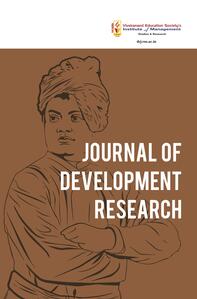
1Department of Economics, Adamas University, Kolkata, West Bengal, India
2Department of Economics, Jadavpur University, Kolkata, West Bengal, India

Creative Commons Non Commercial CC BY-NC: This article is distributed under the terms of the Creative Commons Attribution-NonCommercial 4.0 License (http://www.creativecommons.org/licenses/by-nc/4.0/) which permits non-Commercial use, reproduction and distribution of the work without further permission provided the original work is attributed.
The effect of the affirmative action policy on higher educational enrolment in India is addressed here. This article tries to identify the factors that play important roles in enhancing the enrolment of young people from ethnically disadvantaged groups, specifically Scheduled Castes (SC), Scheduled Tribes (ST) and Other Backward Classes (OBC) in higher education. Using the probit regression technique, it finds that females from ST communities have a lower chance of enrolling in higher education. Conversely, the probability of young females participating in higher education is higher in the OBC community. At the household level, household income, smaller family size and household location increase the probability of enrolment in higher education among young individuals from the three castes considered. Furthermore, a larger number of higher educational institutions and increased government spending on higher education also contribute to higher enrolment rates for young individuals from these socioeconomically disadvantaged households.
Higher education, SC, ST, OBC, NSSO, probit model
Agarwal, P. (2009). Indian Higher Education: Envisioning the Future. Sage Publications.
All India Survey on Higher Education. (2017–2018). Ministry of Human Resource Development; Department of Higher Education, New Delhi.
All India Survey on Higher Education. (2019–2020). Ministry of Human Resource Development; Department of Higher Education, New Delhi.
Bagde, S., Epple, D., & Taylor, L. (2016). Does affirmative action work? Caste, gender, college quality, and academic success in India. The American Economic Review, 106(6), 1495–1521.
Basant, R., & Sen, G. (2010). Who participates in higher education in India? Rethinking the role of affirmative action. Economic & Political Weekly, 45(39), 62–70.
Basant, R., & Sen, G. (2019). Quota-based affirmative action in higher education: Impact on other backward classes in India. The Journal of Development Studies, 56(2), 336–360.
Basant, R., & Sen, G. (2020). Quota-based affirmative action in higher education: Impact on other backward classes in India. The Journal of Development Studies, 56(2), 336–360.
Bhattacharjee, A. (2019). Spillovers in affirmative action: Evidence from OBC quotas in India [Leeds University Business School Working Paper No. 19-03]. Leeds University Business School.
Bhoi, D., & Lakra, N. R. (2022). Marginality, educational opportunity and access to higher education: Experiences of scheduled caste and tribe students in India. Contemporary Voice of Dalit.
Deshpande, A., & Ramachandran, R. (2020). Traditional hierarchies and affirmative action in a globalizing economy: Evidence from India. World Development, 118, 63–78.
Fairlie, R. W. (2012). The effects of home access to technology on computer skills: Evidence from a field experiment. Information Economics and Policy, 24(3–4), 243–253.
Kaaya, G. B., & Waiganjo, E. (2015). Factors affecting women enrollment in technical institutions in Tanzania: A case study of Arusha Technical College. International Journal of Scientific and Technology Research, 4(6), 12–14.
Khanna, G. (2020). Does affirmative action incentivize schooling? Evidence from India. Review of Economics and Statistics, 102(2), 219–233.
Kingdon, G. G. (2005). Where has all the bias gone? Detecting gender bias in the intrahousehold allocation of educational expenditure. Economic Development and Cultural Change, 53, 409–452.
Kosha, A., Oriya, S., Nabi, T., Halim, S., Hofyani, S., Liwal, A., & Noormal, B. (2014). The resilience of women in higher education in Afghanistan. Resilience in Education Settings (RES)-Research Studies Series. World Bank.
Kuglen, C., & Kumar, S. (2017). Gender disparities in higher education enrolment: A comparative analysis. Journal of Higher Education, 28(2), 45–60.
Makoye, J. N. (2003). Strategic issues in ICTE implementation in schools and teacher colleges: The Tanzanian Context. The Tanzania Education Journal, 23(22), 22–33.
Niu, L. (2017). Family socioeconomic status and choice of STEM major in college: An analysis of a national sample. College Student Journal, 51(2), 218–312.
Nwojiewho, D. I., & Deebom, T. M. (2017). Gender disparity towards students enrolment in technical education in rivers state: Causes, effects and strategies. International Journal of Research-Granthalaya, 31(10), 1–10.
Periodic Labour Force Survey (2017–2018). Published by Ministry of Statistics & Program Implementation, National Statistics Office.
Rammohan, A., & Vu, P. (2018). Gender inequality in education and kinship norms in India. Feminist Economics, 24(1), 142–167.
Ranahasan, M. A. (2006). Under-representation of disadvantaged classes in colleges: What do the data tell us? Economic & Political Weekly, 3791–3796.
Sinha, S. (2008). Identification of educationally backward districts higher education. In Higher education in India: Issues related to expansion, inclusiveness, quality and finance (pp. 56–78). University Grants Commission.
Song, L., Appleton, S., & Knight, J. (2006). Why do girls in rural China have lower enrollment? World Development, 34(9).
Sundaram, K. (2006). On backwardness and fair access to higher education. Economic & Political Weekly, 41(50), 1639–1653.
Swain, J. (2022). A review of literature on gender disparity in higher education system in India. International Journal of Research Trend and Innovation, 7(3), 22–25.
Thasniya, K. T. (2014). Girls’ higher education in the era of globalization: Issues of access and quality. International Journal of Education and Psychological Research, 3(4), 18–21.
Tilak, J., & Mazumder, P. K. (2016). Inequality in access to higher education in India between the poor and the rich. An Analysis of 64th and 71st Rounds of NSSO Data (pp. (pp. 5173–5182) [Working Paper]. Council for Social Development.
Tilak J. B. G., Choudhury P. K. (2019). Inequality in access to higher education in India between the poor and the rich: An analysis of the 64th and 71st Rounds of NSSO Data (2007–08 and 2013–14). (Working paper CSD-2/2019). New Delhi, India: Council for Social Development.
Weisskopf, T. E. (2004). Impact of reservation on admissions to higher education in India. Economic & Political Weekly, 39(39), 4339–4349. https://doi.org/10.1177/2455328X221129453.